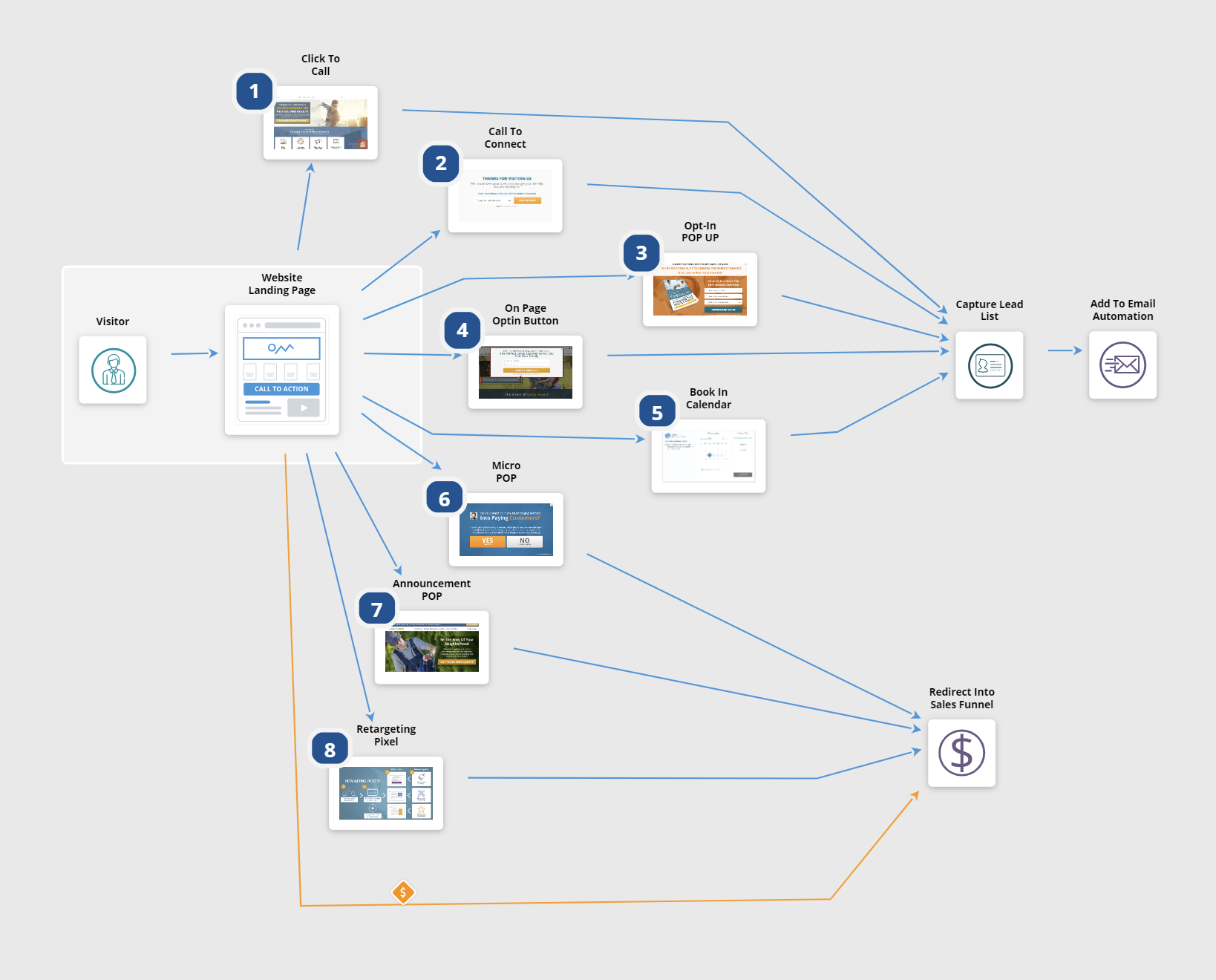The Unmissable Benefits of Website Lead Capture Essentials for E-Commerce Growth

In recent years, we have witnessed an unprecedented surge in e-commerce growth. The digital landscape has opened up new frontiers, empowering anyone to turn their entrepreneurial dreams into reality. Yet, amid the online buzz, e-commerce businesses face several challenges.
One of the most significant is capturing potential customers' details for robust customer conversion strategies. If you're an e-commerce entrepreneur who is still unsure about investing in website lead capture systems, this article is for you.
Efficient Retargeting: A Multi-Faceted Strategy for Customer Re-engagement
First and foremost, website lead capture tools allow for efficient retargeting of potential customers who've shown interest in your products. Here's how it works: A user lands on your online store, browses through your inventory but leaves without making a purchase. If you've successfully captured their information, such as their email address, you can implement targeted retargeting campaigns to encourage them to complete a transaction.
Imagine sending them a curated list of products they’ve previously looked at, along with a special discount code. The chances of converting these warm leads into paying customers are considerably higher than trying to woo cold prospects. In a cluttered online marketplace, retargeting through website lead capture is invaluable.
But what if they left your ecommerce site without giving up any information.
Effective Retargeting: Far More Than Just a Follow-Up Email
Retargeting is a multi-faceted strategy that allows you to re-engage potential customers in numerous ways, significantly boosting your chances for conversion. Understanding the steps of retargeting and the technologies involved can make all the difference. Let's dig deeper into these aspects:
Pixeling for Precise Tracking
One of the first steps in retargeting is "pixeling" your email and website visitors. This involves placing a small piece of code inside your email client and on your website that tags visitors with a cookie. This cookie then tracks their activities on your site—what pages they visit, what products they look at, and even how long they spend on each page. With pixel data, you can create highly targeted ads that speak directly to each visitor's interests.
Digital Display Ads Based on User Behavior
Once you've collected pixel data, you can leverage it to create digital display ads that are tailored to the specific pages or products a visitor has viewed on your site. For example, if someone visited the laptop section of your electronics e-commerce store but didn't make a purchase, you could set up a digital display ad featuring laptops to appear when they browse other websites. This keeps your brand and product at the top of their mind, encouraging them to return to your site.
Segmentation for Greater Impact
Retargeting becomes even more potent when you segment your captured leads. For instance, you can categorize visitors based on the types of products they viewed, how far they went in the checkout process, or their overall browsing behavior. This enables you to create specialized retargeting campaigns for each segment. A visitor who looked at kitchen appliances might receive ads for an upcoming sale on blenders, while someone who abandoned a cart with kids' toys might get an offer for free shipping on those items.
Timing is Everything
Efficient retargeting is also about timing. If you retarget too soon, the potential customer may feel rushed or overwhelmed. Too late, and they may have moved on to another brand. The ideal timing varies by industry and product but should be informed by analytics and customer behavior data.
Pixeling and detailed tracking thus enable a hyper-focused, efficient retargeting strategy that can be tailored in real-time based on user interaction and behavior. The end result is a noticeable increase in conversions and a more cost-effective use of your marketing budget.
Minimized Cart Abandonment
One of the most frustrating challenges in e-commerce is shopping cart abandonment. According to studies, the average online shopping cart abandonment rate is around 69.57%. That's a lot of potential revenue slipping through your fingers. Website lead capture can significantly minimize this.

By capturing the leads of customers who've shown intent—such as those who've added items to their online shopping cart—you can implement strategies to recover potentially lost sales. Sending follow-up emails with cart reminders, or incentives like free shipping or a 10% off coupon, can nudge the customer to complete the purchase they initially intended to make.
Personalized Experience
Another compelling benefit of capturing leads is the ability to offer a personalized shopping experience. Using data collected from a visitor’s past interactions with your website, you can customize the content they see. For instance, if a visitor previously explored the men’s footwear section, a strategically placed pop-up featuring a new arrival in men’s shoes can attract their attention. Such personalized experiences not only delight customers but also drive them towards making a purchase, thereby boosting customer conversion rates.
Boosted Sales: The Direct Link to Revenue Generation
There is a direct correlation between effective website lead capture and increased sales. A well-implemented lead capture strategy can transform your e-commerce site from a digital catalog into a high-conversion sales machine. Whether it's through retargeting ads, personalized experiences, or recovering abandoned carts, each captured lead has a monetary value attached to it. Over time, these leads add up to contribute significantly to your bottom line.
The positive impact of website lead capture on your bottom line is both immediate and long-lasting. This isn't merely a theoretical benefit; it's a measurable outcome. Every time you capture a lead—be it an email address, phone number, or even just tracking user behavior—you’re effectively setting the stage for an array of potential sales opportunities.
Improved Analytics
Capturing leads doesn't just help with sales and customer experiences; it also provides a treasure trove of data. This information is invaluable for understanding customer behavior, preferences, and pain points. Advanced analytics can show the customer journey, from the first interaction to the eventual sale or bounce rate. By studying these analytics, you can fine-tune your website and marketing strategies for even better performance in the future.
Practical Tips for Implementation: Transforming Theory into Action
Knowing the importance of lead capture is one thing, but practical implementation is another ball game altogether. Here's how you can effectively put these strategies into action on your e-commerce platform, complete with illustrative examples for each tip:

- Use Attention-Grabbing Pop-ups: The Art of the Immediate Offer Incorporate eye-catching pop-ups that come alive at strategically timed moments during the visitor’s journey. For example, you could have a pop-up appear after a visitor has spent 30 seconds browsing your online shoe store, offering a 10% discount on their first purchase if they sign up for your newsletter. Make sure the offer is enticing enough to encourage immediate action.
- Exit-Intent Technology: The Last-Second Save This technology triggers a pop-up or a special message when a visitor shows signs of exiting your website. For instance, if a customer browses through several pages of your online bookshop but moves their cursor to close the tab, an exit-intent pop-up could appear, offering a buy-one-get-one-free deal on select titles. This can often convert an 'almost lost' visitor into a paying customer.
- Landing Pages: Specialized Entry Points Create specific landing pages optimized for capturing leads. If you're running a campaign for summer apparel, direct traffic to a dedicated landing page filled with your best summer outfits. Make it easy for the visitor to subscribe to updates by including a simple, yet compelling, lead capture form promising exclusive early-bird access to summer sales.
- A/B Testing: The Science of Choice Always conduct A/B tests on different versions of lead capture elements to identify what’s most effective. For example, you could test two different pop-up designs on your organic food e-commerce site—one offering a free recipe eBook and another offering a 5% discount on the first order. Monitoring which version gets more sign-ups will help you optimize for the future.
- Automate Follow-Ups: Consistency Without the Hassle Leverage automated email marketing tools to send a series of follow-up emails to your captured leads. Suppose someone adds a set of kitchen utensils to their cart on your home goods site but doesn't check out. An automated email could be sent within hours, reminding them of their abandoned cart, followed by another email a day later offering a 10% discount code to finalize the purchase. By integrating these practical tips into your e-commerce platform, you can significantly enhance your website lead capture capabilities, improving not just your customer conversion rates but also your overall sales and customer engagement metrics.

Final Thoughts
With the e-commerce landscape becoming more competitive by the day, capturing leads has evolved from a ‘good-to-have’ to an essential strategy. Not only does it help with efficient retargeting and minimizing cart abandonment, but it also enriches customer experiences and boosts sales.
Plus, the analytics garnered from lead capture can inform and improve future strategies.
Transform Your E-commerce Business Today
By now, you've gained a comprehensive understanding of the invaluable benefits that website lead capture can bring to your e-commerce business. From efficient retargeting to boosted sales and beyond, the advantages are truly game-changing. But understanding the benefits is just the starting point—the next step is actionable implementation.
You don't have to navigate these complex waters alone. Our agency specializes in creating tailored lead capture strategies that drive tangible results. With eight distinct lead capture services to choose from, we offer unmatched flexibility and expertise to elevate your e-commerce business to new heights.
So why wait? Your business deserves a lead capture strategy as unique as your offerings. Let's find out which methods are best suited to accelerate your growth. Click the link below to set up a free 30-minute consultation with our lead capture experts, and take the first step toward transforming your e-commerce performance today.
Schedule Your 30-Minute Free Consultation Now
Unlock the full potential of your e-commerce business. Take action now, and let's build your roadmap to success together.
 Add Row
Add Row  Add
Add 


Write A Comment